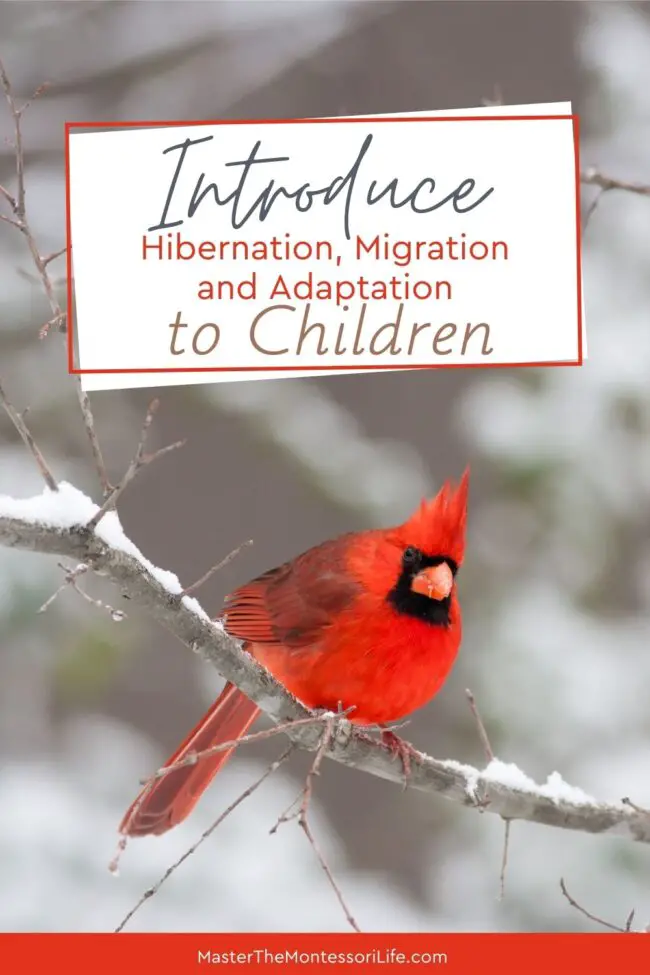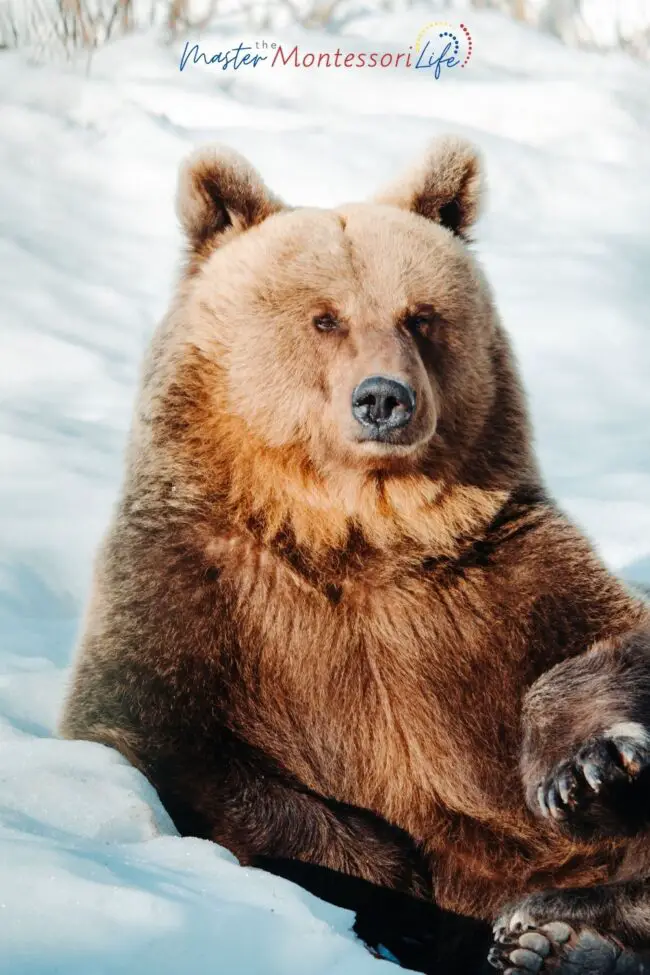Come and learn of a great set of activities that you can do with your children to introduce them to the concepts of hibernation, migration and adaptation that animals do in winter.
Just like any creature with a brain, animals have a survival instinct… probably stronger than humans, but that is open for debate. Regardless, it is important to study and learn about how animals survive in Winter. Animals in Winter and some of the most fascinating ones to study, compare and contrast.
When you introduce your children to the concepts of hibernation, migration and adaptation, you will love to learn how they find food, which ones follow each of these survival techniques and so much more.

What is Hibernation?
Some animals are cold blooded, while others are warm blooded, and there is a difference between the two. Some animals hibernate during the winter months in order to adapt to changes in their environment.
During the cold season, hibernating is a long period of semi-sleep that is necessary for an animal’s survival because food is scarce and the body temperature drops and the heart rate slows down.
While they remain in their homes during the winter months, they do not go out and about in the cold to conserve their energy.
Generally speaking, animals that live in cold climates are more likely to hibernate, though this is not true for all cold-weather animals (polar bears are an example of an animal that does not hibernate).
You might also like to research the term: true hibernation. A fun activity: research to see if the Arctic ground squirrel hibernates.

When you introduce your children to the concept of hibernation, try this:
- For younger children, you will want to pretend that you are bears and fall asleep.
- For older children, use some hands-on activities that will help them learn some of the animals that hibernate. Read on for more details.
What is Migration?
In biology, migration is defined as the movement of animals from one location to another, typically in search of food or warmer temperatures. Thousands of different animal species, including birds, reptiles, and even insects, take part in winter migration.
In fact, most animals that do not hibernate take part in some form of migration at some point during the year. There are different terms within the migration terms. Internal migration is one of them.
For example, this is when animals move from a colder state in the United States to a warmer state for a few months. They don’t leave the same “local” area.
Others travel to other countries or even to other continents altogether. To learn more, look into the International Organization for Migration.
When you introduce your children to the concept of migration, try this:
- For younger children, pretend that you are birds standing on a piece of paper that says “North America” and pretend to fly to another piece of paper about 10 feet away that says “South America.”
- For older children, create a map of the world tracing the migration routes for specific animals. Choose one that is local or one that travels halfway around the world. Read on for more information.
What is Adaptation?
Animal adaptations is when winter comes and animals adapt to the temperature and environmental changes instead of hibernating or migrating. Just like with migration, there are different types of adaptation.
There are structural, behavioral and habitat adaptations. Each one has its own intricacies and details that you and your children will love to research because they are so interesting.

When you introduce your children to the concept of adaptation, try this:
- For younger children, you will want to have children pretend to be animals. You hold up a paper with a sun on it. Then, put the sun away and put up a paper with a snowflake. When the animals see it, they brrrr and pretend to be cold. Have a blanket or two nearby so they can go underneath. This shows children how these animals stay in the same place; they just find a warmer home during the winter months.
- For older children, provide them some notebooking pages on adaptation where children can jot down their notes about their research on adaptation. Read on for more details on this.
Animals in Winter Bundle 1
The best recommendation that I can give you is for you to check out this bundle. Why? because it covers everything you need to introduce hibernation, migration and adaptation to children the right way. It will be easy and effortless to go through these printable hands-on activities that are adaptable for children of different ages. And the best part is that the lesson plans are included!
This Animals in Winter bundle focuses on what they do in winter. Some adapt, others hibernate and yet others migrate. This includes 7 activities and 26 pages total to print over and over as needed. What do you think? Isn’t this amazing?
It is all you need to get started on this wonderful Animals in Winter journey. Make it a unit study or as you find relevant. All of the activities work well together or as stand-alone activities. I love that flexibility.
 Sale!
Sale!
Animals in Winter Adaptation, Hibernation & Migration Bundle 1
$24.50 $17.00
This Animals in Winter bundle focuses on what they do in winter. Some adapt, others hibernate and yet others migrate. This includes 7 activities and 26 pages total to print over and over as needed.
1 Animals in Winter Notebooking Pages
2 Pictures of Animals that Adapt
3 Pictures of Animals that Hibernate
4 Pictures of Animals that Migrate
5 What is Adaptation? Topic Overview
6 What is Hibernation? Topic Overview
7 What is Migration? Topic Overview
You might also enjoy these relevant topics:
Episode 51: Montessori Friendly Printable Winter Activities You Need
Episode 52: 3 Winter-Themed Fine Motor Skills Hands-on Activities
My Montessori Holiday Gift Guide {Free Printable}
- Introduce Hibernation, Migration and Adaptation to Children
 When you introduce your children to the concepts of hibernation, migration and adaptation, you will love to learn how they find food, which ones follow each of these survival techniques and so much more.
When you introduce your children to the concepts of hibernation, migration and adaptation, you will love to learn how they find food, which ones follow each of these survival techniques and so much more. - Montessori Farm Sensory Bin: Hands-On Learning
 A Montessori farm sensory bin is simple to assemble, rooted in purposeful work, and designed to invite deep exploration.
A Montessori farm sensory bin is simple to assemble, rooted in purposeful work, and designed to invite deep exploration. - Tips to incorporate Fall into your Montessori environment
 Come and find out how you can highlight and celebrate Fall in your Montessori environment without stressing out about it.
Come and find out how you can highlight and celebrate Fall in your Montessori environment without stressing out about it. - Hands-On Fun: 3 Montessori Practical Life Activities for Fall
 These simple Montessori Practical Life activities for Fall are easy to do anytime you have the materials ready.
These simple Montessori Practical Life activities for Fall are easy to do anytime you have the materials ready. - Embracing Autumn: A Montessori Guide to Fall Fun
 Spread the love The arrival of autumn brings a special kind of magic. The air turns crisp and leaves paint…
Spread the love The arrival of autumn brings a special kind of magic. The air turns crisp and leaves paint… - Montessori Toddler Essentials
 The Montessori method offers a pathway with a series of Montessori toddler essentials that you will find helpful.
The Montessori method offers a pathway with a series of Montessori toddler essentials that you will find helpful.





Leave a Reply